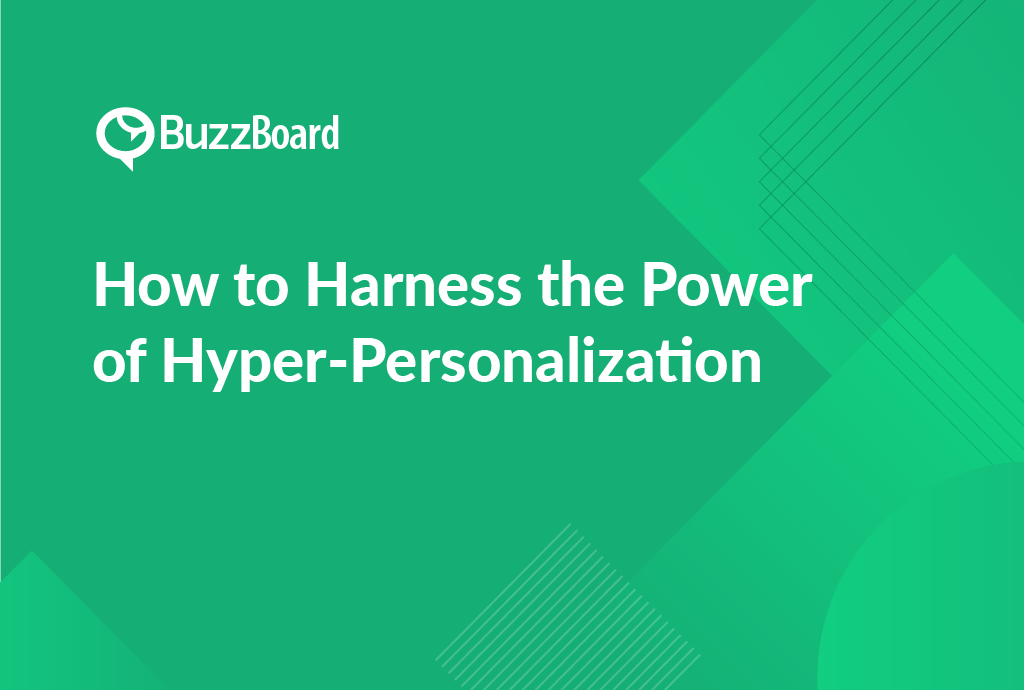Unlock the Power of Hyper-Personalization
Discover how to harness the power of hyper-personalization to drive customer engagement, increase conversions, and boost revenue. Learn the key strategies and best practices for implementing hyper-personalization in your business, including data-driven marketing, AI-powered personalization, and continuous optimization. Get ready to revolutionize your customer experience and stay ahead of the competition!
Understanding the Concept of Hyper-Personalization and Its Benefits
Hyper-personalization is an advanced approach to delivering personalized experiences that consider a customer’s behavior in real-time. For astute sales professionals at digital marketing agencies, it’s a crucial concept that can produce remarkable results for your small and local business clients.
Hyper-personalization’s power comes from its capability to utilize artificial intelligence (AI) and real-time data. Businesses can create highly relevant, immediate experiences resonating with individual customers using hyper-personalization. This level of personalization can significantly enhance customer satisfaction and engagement, leading to increased sales and brand loyalty.
Implementing hyper-personalization necessitates a technical and strategic approach that is both comprehensive and nuanced. To succeed, you must analyze vast volumes of data swiftly and apply insights in real-time. Advanced technologies like AI and machine learning can be incredibly useful in this aspect, allowing you to process and analyze large datasets quickly and accurately.
However, implementing hyper-personalization is not a one-time task. It requires a committed effort to testing, learning, and optimizing. Your clients’ customer needs will evolve over time, and your hyper-personalization strategies should adapt accordingly. This means continuously monitoring customer behavior and preferences, and making adjustments to your strategy as needed.
To get started, it’s essential to develop a deep understanding of your customers. This involves understanding who they are, what they want, and how they behave across various channels. This requires a comprehensive approach that incorporates data from multiple sources, including social media, email marketing, and customer feedback.
Once you have a solid understanding of your customers, you can begin to develop targeted marketing campaigns that resonate with your target audience. This may involve creating personalized content, offers, and promotions that are tailored to individual customers or segments of customers.
Remember, the ultimate goal of hyper-personalization is to make your clients’ customers feel recognized and valued. When executed correctly, it can generate incredible business results and offer a strong competitive edge.
Start using hyper-personalization today and witness the transformation it can engage in your clients’ businesses. For more insights and guidance, consult our comprehensive guide on elevating your personalization strategies. This guide provides a detailed overview of the hyper-personalization process, including tips and best practices for implementing successful hyper-personalization campaigns.
By following the steps outlined in this guide, you can unlock the full potential of hyper-personalization and take your clients’ businesses to the next level. Whether you’re looking to improve customer engagement, increase conversions, or drive revenue growth, hyper-personalization can help you achieve your goals and stay ahead of the competition.
Implementing hyper-personalization requires a technical and strategic approach that is both comprehensive and nuanced. By understanding your customers, developing targeted marketing campaigns, and continuously monitoring and optimizing your strategy, you can create a personalized experience that resonates with your target audience and drives business results.
The Role of Hyper-Personalization in Successful Business Strategies
In today’s intensely competitive digital sales and marketing landscape, hyper-personalization is fast becoming a critical differentiator. The true strength of hyper-personalization lies in its capacity to craft unique, bespoke experiences for each customer, significantly augmenting their connection with your brand. By leveraging customer data and analytics, businesses can create personalized interactions that resonate with their target audience, fostering a deeper sense of loyalty and engagement.
Hyper-personalization extends beyond merely addressing the customer by their first name in emails. It necessitates getting a comprehensive grasp of your customer’s requirements, desires, and shopping habits. This enables you to tailor marketing messages based on customer data, creating a targeted strategy that not only bolsters customer engagement but also favorably impacts conversion rates and customer loyalty.
For a small or local business trying to make its mark in a saturated market, maximizing the benefits of hyper-personalization could entail leveraging data insights to provide timely, pertinent, and highly personalized offers. This could vary from sending personalized product suggestions based on browsing history to real-time adjustment of pricing and promotions per purchasing behavior. By doing so, businesses can create a seamless and intuitive customer experience that sets them apart from the competition.
The significance of hyper-personalization in successful business strategies is irrefutable. It empowers companies to foster deeper relationships with their customers while boosting growth and profitability. By leveraging customer data and analytics, businesses can create targeted marketing campaigns that resonate with their target audience, driving conversions and revenue growth.
However, successful deployment demands a blend of sturdy data infrastructure, analytics, and imaginative strategy. Businesses must invest in robust data management systems that can handle large volumes of customer data, as well as advanced analytics tools that can help them make sense of this data. Additionally, businesses must develop a clear and compelling brand narrative that resonates with their target audience.
Don’t forget, the only thing superior to a satisfied customer is a completely understood and valued one. By leveraging hyper-personalization, businesses can create a loyal customer base that drives growth and profitability. It’s a strategy that requires a deep understanding of customer behavior and preferences, as well as the use of cutting-edge technology and data analytics.
The role of hyper-personalization in successful business strategies is undeniable. By leveraging customer data and analytics, businesses can create targeted marketing campaigns that resonate with their target audience, driving conversions and revenue growth. It’s a strategy that requires a blend of data infrastructure, analytics, and imaginative strategy, but the rewards are well worth the effort.
How to Implement Hyper-Personalization in Your Business Approach
In today’s digital landscape, the power of hyper-personalization is unmatched. As sales professionals serving small and local businesses, incorporating hyper-personalization into your business strategy can deliver substantial results. However, implementing hyper-personalization requires a comprehensive approach that goes beyond simply using a customer’s name in an email.
Hyper-personalization is more than just a buzzword – it’s a strategic imperative for businesses looking to stay ahead of the competition. It involves leveraging real-time data and employing it to tailor content, products, and services to offer an improved customer experience. This approach pushes past the generic ‘dear customer’ to shape a more distinctive, individualized relationship with your customers.
The key to deploying hyper-personalization effectively lies in comprehending your customers’ behavior, interests, and preferences on a detailed level. By examining customer data from diverse touchpoints, you can unearth valuable insights about their purchasing behavior. This information allows you to craft an experience entirely to their liking, escalating both customer satisfaction and retention.
To adopt hyper-personalization, your business needs a paradigm shift from broad marketing strategies toward concentrated, individualized campaigns. This shift requires merging your CRM, big data, and artificial intelligence to reap maximum benefits from hyper-personalization. It’s about developing segments of one and transmitting the correct message at the right time.
To get started, businesses should begin by gathering and analyzing customer data from various sources, including social media, email marketing campaigns, and customer feedback. This data should be used to create detailed customer profiles, including demographic information, purchase history, and behavioral patterns.
Next, businesses should use this data to segment their customer base and create targeted marketing campaigns. This can be achieved through the use of marketing automation software, which allows businesses to automate the process of sending targeted messages to specific customer segments.
In addition to these steps, businesses should also focus on creating personalized content that resonates with their target audience. This can be achieved through the use of content marketing, which involves creating and sharing valuable, relevant, and consistent content to attract and retain a clearly defined audience.
Furthermore, businesses should also prioritize the use of artificial intelligence and machine learning to enhance their hyper-personalization efforts. AI and machine learning can be used to analyze customer data and make predictions about customer behavior, allowing businesses to deliver targeted and personalized experiences to their customers.
Adhering to these steps guarantees that you’re optimizing your approach to hyper-personalization and gaining a competitive edge. For further details on maximizing your hyper-personalization endeavors, be sure to check out external resources and industry reports. To delve deeper into the use of hyper-personalization in digital marketing, visit our previous blog and explore our comprehensive guide to hyper-personalization.
By implementing hyper-personalization, businesses can create a more intimate and personalized relationship with their customers, leading to increased customer satisfaction, loyalty, and retention. It’s an approach that requires a comprehensive understanding of customer behavior and preferences, as well as the use of cutting-edge technology and data analytics. By following these steps, businesses can unlock the full potential of hyper-personalization and reap the rewards of increased customer engagement and loyalty.
Real-Life Examples of Brands Harnessing the Power of Hyper-Personalization Effectively
Harnessing the power of hyper-personalization is more than a trend – it’s a strategic imperative for brands aiming to cultivate loyal customers. By personalizing customer experiences across multiple touchpoints, brands can create memorable online interactions and deliver communication that resonates with their targeted audience. This approach enables brands to build strong relationships with their customers, increasing customer loyalty and driving business growth.
One notable example of successful hyper-personalization is Amazon. Its recommended product system, based on each customer’s search and purchase history, demonstrates effective use of hyper-personalization. This targeted approach suggests products that are likely to appeal to each specific user, increasing the chances of a sale. Furthermore, Amazon’s use of hyper-personalization has substantially increased its cross-selling opportunities and overall revenue.
Another brand maximizing hyper-personalization is Starbucks. The Starbucks app elevates personalization with its rewards program, which includes sustainably packed data such as customer behavior, purchase history, and location. Using this information, Starbucks offers menu recommendations tailored to each customer and personalized rewards. This strategic approach enhances the customer experience, encourages repeat business, and fosters a sense of loyalty among customers.
In addition to these examples, other brands are also leveraging the power of hyper-personalization to drive business results. For instance, Sephora, a leading beauty retailer, uses hyper-personalization to offer personalized product recommendations to its customers. The brand’s “Beauty Insider” loyalty program uses data and analytics to provide customers with tailored product suggestions, increasing customer engagement and driving sales.
Similarly, Domino’s Pizza uses hyper-personalization to offer customized pizza recommendations to its customers. The brand’s “Pizza Builder” tool allows customers to create their own pizzas, and then uses data and analytics to suggest toppings and crust options based on the customer’s preferences.
In addition to these examples, hyper-personalization is also being used in the world of finance. For instance, banks such as Chase and Bank of America are using hyper-personalization to offer personalized financial advice and investment recommendations to their customers.
Salespeople in this digital age must harness hyper-personalization technologies like AI and machine learning to deliver timely and relevant content, fostering meaningful connections with customers. This approach will pave the way for fruitful customer relationships, increased customer loyalty, and ultimately, business growth.
The Challenges and Benefits of Deploying Hyper-Personalization in Your Business
Rising customer expectations have made hyper-personalization a game-changer for businesses. However, realizing the full potential of hyper-personalization isn’t without its challenges. As businesses navigate the delicate balance between individualized content and maintaining client privacy, regulators are increasingly tightening data protection laws globally. To ensure this balance, stringent cybersecurity measures are vital to preserve sensitive information.
One of the primary concerns is data privacy and security. With the rise of data breaches and cyberattacks, it’s crucial for businesses to implement robust security measures to protect customer data. This includes encrypting sensitive information, implementing secure data storage solutions, and conducting regular security audits to identify vulnerabilities.
Another significant challenge is the labor-intensive and resource-heavy task of data collection and analysis. To make use of hyper-personalization, businesses must understand their customers’ preferences, demographic details, and psychographic profiles. This requires a deep understanding of customer behavior, preferences, and motivations. However, this information can be difficult to obtain, especially for businesses with large customer bases.
Moreover, the sheer volume of data generated by customers can be overwhelming, making it challenging to analyze and make sense of it all. This is where technology comes in, providing businesses with the tools and platforms necessary to collect, analyze, and act on customer data.
Despite these challenges, the benefits of hyper-personalization are significant. By delivering unique content to each customer, businesses can improve customer engagement, increase loyalty, and drive revenue growth. For example, Netflix, a pioneer in hyper-personalization, saved $1 billion in 2017 by using hyper-personalization to curb customer attrition.
Hyper-personalization also enables businesses to identify and capitalize on new revenue streams. By offering tailored products and services, businesses can increase average order value, reduce churn rates, and improve customer retention. Additionally, hyper-personalization can help businesses stay ahead of the competition, as customers increasingly expect personalized experiences from the brands they interact with.
If your business is ready to explore hyper-personalization, a comprehensive plan backed by apt technology can turn these challenges into opportunities. By investing in the right tools and platforms, businesses can streamline data collection and analysis, improve customer engagement, and drive revenue growth.
To get started, businesses should begin by identifying their goals and objectives for hyper-personalization. This includes understanding customer needs, preferences, and behaviors, as well as identifying areas for improvement and opportunities for growth. Next, businesses should develop a comprehensive plan for data collection and analysis, including the implementation of robust security measures to protect customer data.
Finally, businesses should invest in technology that can help them collect, analyze, and act on customer data. This includes customer relationship management (CRM) software, marketing automation platforms, and data analytics tools. By leveraging these tools and platforms, businesses can unlock the full potential of hyper-personalization and deliver highly personalized experiences to their customers.
While deploying hyper-personalization in your business comes with its challenges, the benefits are significant. By understanding customer needs, preferences, and behaviors, businesses can improve customer engagement, increase loyalty, and drive revenue growth. With the right technology and strategy in place, businesses can overcome the challenges of hyper-personalization and reap the rewards of delivering highly personalized experiences to their customers.










